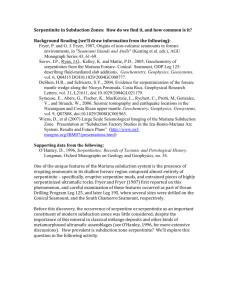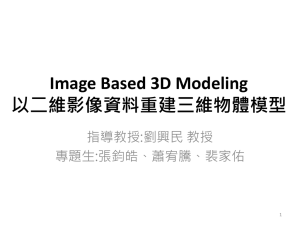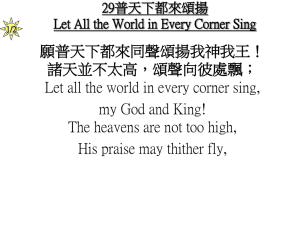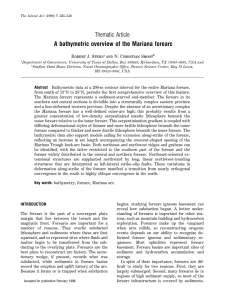GSAVancouverHyndmanReduced
advertisement
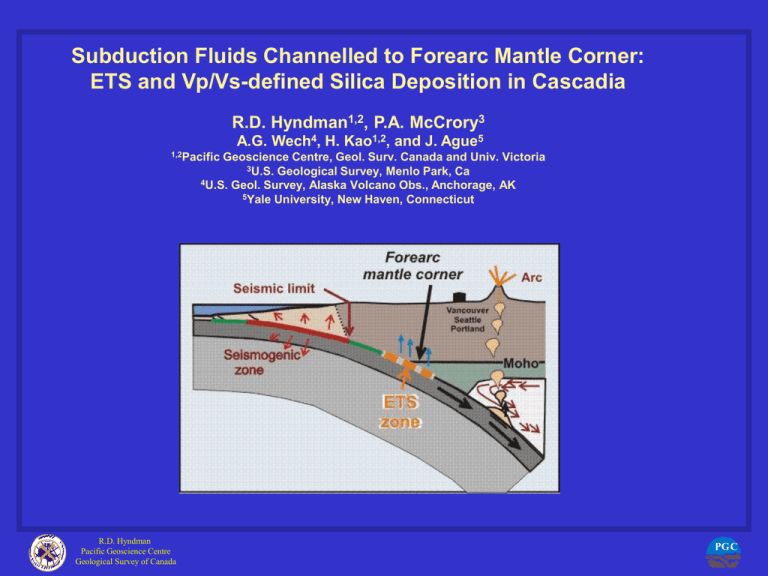
Subduction Fluids Channelled to Forearc Mantle Corner: ETS and Vp/Vs-defined Silica Deposition in Cascadia R.D. Hyndman1,2, P.A. McCrory3 A.G. Wech4, H. Kao1,2, and J. Ague5 1,2Pacific Geoscience Centre, Geol. Surv. Canada and Univ. Victoria 3U.S. Geological Survey, Menlo Park, Ca 4U.S. Geol. Survey, Alaska Volcano Obs., Anchorage, AK 5Yale University, New Haven, Connecticut R.D. Hyndman Pacific Geoscience Centre Geological Survey of Canada PGC ETS zone is controlled by fluids expelled into crust at forearc mantle corner Cascadia 3 1 2 Episodic Tremor and Slip (ETS) Seismic tremor with no clear onset Slow slip events on the subd. thrust downdip of seismogenic zone Tremor at 35 km, 500C, where thrust should be aseismic! What generates ETS and what controls controls downdip location? 1. Not continuous with seismogenic zone; ~50 km gap 2. ETS associated with upward fluid expulsion at forearc mantle corner 3. Silica deposition above corner from upward fluid expulsion E Time After Rogers and Dragert (2003) Cascadia Rupture Area Review Hyndman, JGR 2013 Thermal Constraint 350-450C Geodetic Data "Locked/transition Zone" 1. Geodetic locked/transition GPS, levelling, tide gauge, etc 2. Thermal constraint, 350-450C Heat flow etc. 3. Coseismic subsidence Coastal marsh data 4. Thrust reflection character Thin seismic to thick ductile 5. Forearc basins 6. Landward limit small eqs. Locked/transition zone vs slow slip and tremor (Wang et al., Kao et al., a ~Forearc Mantle Slow Slip Corner 50% rupture b event N ed ck on area 47 0 0 2 2 Slip (cm) 4 4 Tremor 46 0 100 200 km Tremo r Slow Slip event Transition Lo si ti L ock ed Tr an 48N Wech et al.) Cascadia forearc mantle corner and ETS tremor Summary McCrory et al., GGG 2014 Corner Forearc Mantle Corner Forearc Moho Mantle Wedge Tremor Wech et al. (2010) Cascadia forearc mantle corner and ETS tremor transition Corner: McCrory et al. (2012) locked Locked zones: Holtkamp and Brudzinski (2010) Dehydration fluids of downgoing plate Channelled to corner by anisotropic sheared serpentinite (based on Kawano et al., 2011) Evidence for fluids in deposited silica from rising silica saturated fluids volcanic arc Vancouver Is. silica removed from rising water SILICA ANDTremor SERPENTINITE IN SUBDUCTION FOREARC silica si lic Slow slip? as at u r ate d flu i ds serpentinite o Quartz veins in Otago Schists accretionary prism from rising subduction slab-derived water Breeding and Ague (2002) Cascadia shear tomography Low Poisson's Ratio (and Vp/Vs) over forearc mantle corner <0.22, only silica is that low Poisson's Ratio related to Vp/Vs Ramachandran and Hyndman (2010) Low Poisson’s Ratio corresponds To tremor location Other Hot Subduction Zones For both SW Japan and Mexico, ETS lies approx. over forearc mantle corner SW Japan has older subducting crust and is cooler than Cascadia. Its thermally limited seismogenic zone extends nearly to forearc mantle corner so a smaller gap Mexico subduction zone has variable age subducting crust; there is a gap between seismogenic zone and ETS (and mantle corner) for hotter northern part Summary 1. Gap between Cascadia seismic rupture zone and ETS slow slip 2. ETS not T controlled 3. ETS Overlies mantle corner 4. Low permeability and anisotropic serpentinite channel fluids from dehydrating ocean crust to the corner 5. Low Poisson's Ratio evidence for silica saturated fluids in crust overlying corner. Quartz veins formed with fluid cooling above corner Thank you Roy Hyndman, PGC-GSC


